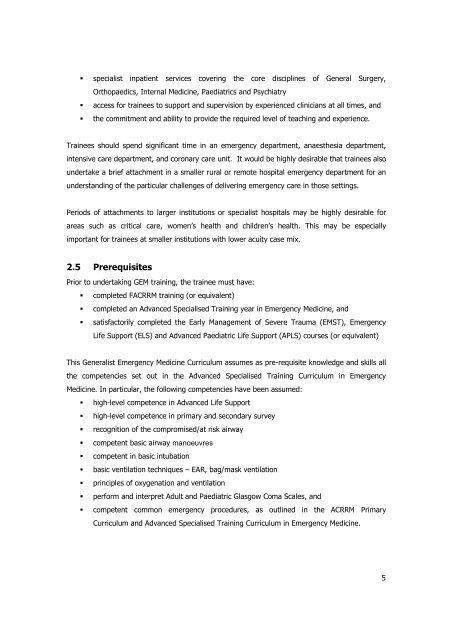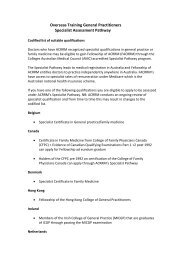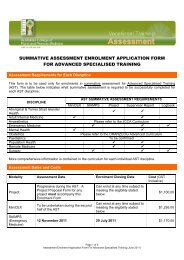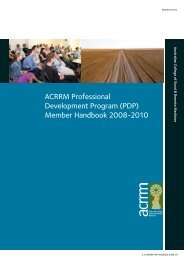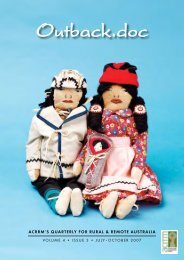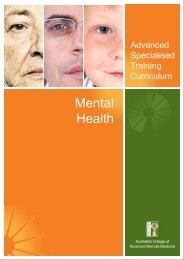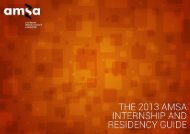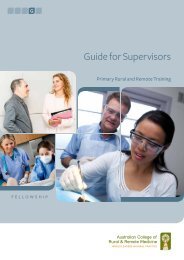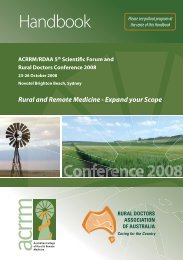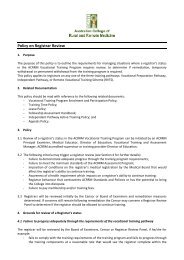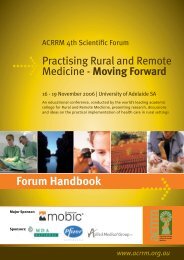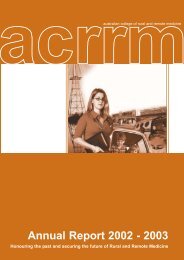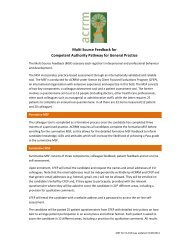ACRRM GEM Curriculum - Final July09 - Australian College of Rural ...
ACRRM GEM Curriculum - Final July09 - Australian College of Rural ...
ACRRM GEM Curriculum - Final July09 - Australian College of Rural ...
Create successful ePaper yourself
Turn your PDF publications into a flip-book with our unique Google optimized e-Paper software.
specialist inpatient services covering the core disciplines <strong>of</strong> General Surgery,<br />
Orthopaedics, Internal Medicine, Paediatrics and Psychiatry<br />
access for trainees to support and supervision by experienced clinicians at all times, and<br />
the commitment and ability to provide the required level <strong>of</strong> teaching and experience.<br />
Trainees should spend significant time in an emergency department, anaesthesia department,<br />
intensive care department, and coronary care unit. It would be highly desirable that trainees also<br />
undertake a brief attachment in a smaller rural or remote hospital emergency department for an<br />
understanding <strong>of</strong> the particular challenges <strong>of</strong> delivering emergency care in those settings.<br />
Periods <strong>of</strong> attachments to larger institutions or specialist hospitals may be highly desirable for<br />
areas such as critical care, women’s health and children’s health. This may be especially<br />
important for trainees at smaller institutions with lower acuity case mix.<br />
2.5 Prerequisites<br />
Prior to undertaking <strong>GEM</strong> training, the trainee must have:<br />
completed F<strong>ACRRM</strong> training (or equivalent)<br />
completed an Advanced Specialised Training year in Emergency Medicine, and<br />
satisfactorily completed the Early Management <strong>of</strong> Severe Trauma (EMST), Emergency<br />
Life Support (ELS) and Advanced Paediatric Life Support (APLS) courses (or equivalent)<br />
This Generalist Emergency Medicine <strong>Curriculum</strong> assumes as pre-requisite knowledge and skills all<br />
the competencies set out in the Advanced Specialised Training <strong>Curriculum</strong> in Emergency<br />
Medicine. In particular, the following competencies have been assumed:<br />
high-level competence in Advanced Life Support<br />
high-level competence in primary and secondary survey<br />
recognition <strong>of</strong> the compromised/at risk airway<br />
competent basic airway manoeuvres<br />
competent in basic intubation<br />
basic ventilation techniques – EAR, bag/mask ventilation<br />
principles <strong>of</strong> oxygenation and ventilation<br />
perform and interpret Adult and Paediatric Glasgow Coma Scales, and<br />
competent common emergency procedures, as outlined in the <strong>ACRRM</strong> Primary<br />
<strong>Curriculum</strong> and Advanced Specialised Training <strong>Curriculum</strong> in Emergency Medicine.<br />
5


